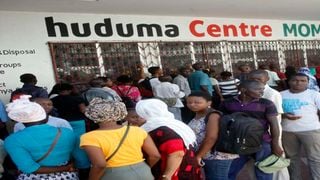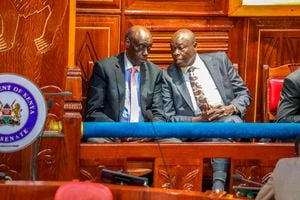
Mombasa residents queue at the General Post Office along Digo Road on April 15, 2019, to register for Huduma Namba.
| File | Nation Media GroupNews
Premium
Puzzle of missing 1.7m potential new voters
What you need to know:
- With the elections shaping up into a battle for numbers, the 2021 Economic Survey, published last week, paints a grim picture about IDs that should concern political bigwigs.
Nearly half of eligible youth may have failed to apply for national identity cards due to the tough containment measures aimed at combating the Covid-19 pandemic.
Government data released last week indicates that the number of ID applications decreased by 47.9 per cent in 2020, raising fears that most young people who are 18 years old may be disenfranchised and locked out of the 2022 General Elections.
With the elections shaping up into a battle for numbers, the 2021 Economic Survey, published last week, paints a grim picture about IDs that should concern political bigwigs.
The number of applications dropped from 1,244,257 in 2019 to 648,553 in 2020 while the ID cards produced and those collected declined by 22.2 per cent and 19 per cent respectively as a result of Covid-19 measures.
The National Registration Bureau received 5.62 million applications for new ID cards between 2017 and 2020, data shows.
The figure falls squarely in the projection that IEBC has given as the total number of new voters it is seeking to enlist.
From the 5.62 million applications, the agency produced 5.31 million cards but only 3.62 million have been collected, raising questions about the whereabouts of over 1.7 million ID cards that are pending in registration offices countrywide.
The electoral agency, IEBC, says it wants to enlist six million new voters who had not turned 18 by 2017 or who were eligible but had failed to register.
Questions raised
On Wednesday, Nandi Senator Samson Cherarkey questioned the rationale for scaling down the issuing of IDs to young people, claiming it is a scheme to lock them out of the electoral process.
“There are many things being done online – job applications and some as complicated as procurement. What is this about the simple process of applying for an ID that must be done through the physical process?” he said.
He urged the ICT ministry to find ways for citizens to apply for IDs online.
Also read: Huduma Namba anomaly in Mbeere worries MCAs
Voter registration will start in the next two weeks, but it is unlikely that all young people who failed to submit their ID applications because of the pandemic will have acquired the precious documents, which are mandatory for voter listing.
In 2017, a total of 1.23 million applications for new IDs were filed, with the number dropping to 967,651 in 2018 and rising to 1.24 in 2019, only to dip to 648,553 last year.
From the 1.23 million applications in 2017, the government produced 1.322 million cards but only 1.26 million were collected.
A year later, the government received 967,651 new applications, produced 846,019 cards but only 763,601 were collected.
A similar situation was reported in 2019 when 1.24 applications were received but only 1.03 were produced and 883,532 were collected.
County figures
Arid and semi-arid (Asal) counties saw low numbers of applications, with Lamu recording the highest decrease at 80 per cent.
West Pokot, Elgeyo-Marakwet and Samburu also experienced reduced applications at 73.8, 70.7 and 69.4 per cent, respectively.
But applications in Garissa County increased by 35.3 per cent from 4,363 in 2019 to 5,901 in 2020.
“This rise was largely as a result of the government’s verification exercise undertaken in Garissa and Wajir counties for persons with double registration where those found to have been registered more than once were re-registered as Not Previously Registered (NPRs) hence the increased applications,” says the report, which was launched by National Treasury CS Ukur Yatani last week.
Tana River County had the highest increase in the number of ID cards produced, which more than doubled from 3,184 in 2019 to 7,738 in 2020, mainly due to a rapid results initiative conducted in 2020.
Other Asal counties that registered greater numbers of new ID cards were Wajir, Isiolo, Mandera, Turkana and Lamu at 9.9, 59.0, 36.0, 12.6, and 7.2 per cent, respectively.





